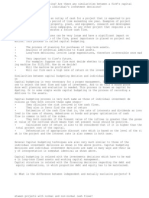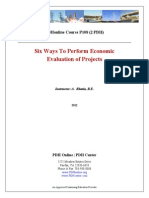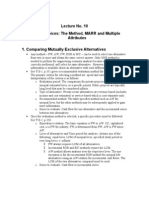0 ratings0% found this document useful (0 votes)
14 viewsCH 1 Foundations of Engineering Economy
CH 1 Foundations of Engineering Economy
Uploaded by
Shanze DaudEngineering economics involves formulating, estimating, and evaluating the expected economic outcomes of alternatives designed to accomplish a defined purpose. It deals with cash flows, times of occurrence of cash flows, interest rates, and measures of economic worth for selecting alternatives. A minimum attractive rate of return is established as a criterion for evaluating project alternatives. Cost of capital depends on financing methods like equity financing using a company's own funds or debt financing by borrowing from outside sources.
Copyright:
© All Rights Reserved
Available Formats
Download as PPTX, PDF, TXT or read online from Scribd
CH 1 Foundations of Engineering Economy
CH 1 Foundations of Engineering Economy
Uploaded by
Shanze Daud0 ratings0% found this document useful (0 votes)
14 views50 pagesEngineering economics involves formulating, estimating, and evaluating the expected economic outcomes of alternatives designed to accomplish a defined purpose. It deals with cash flows, times of occurrence of cash flows, interest rates, and measures of economic worth for selecting alternatives. A minimum attractive rate of return is established as a criterion for evaluating project alternatives. Cost of capital depends on financing methods like equity financing using a company's own funds or debt financing by borrowing from outside sources.
Original Description:
Engineering Economics lecture
Copyright
© © All Rights Reserved
Available Formats
PPTX, PDF, TXT or read online from Scribd
Share this document
Did you find this document useful?
Is this content inappropriate?
Engineering economics involves formulating, estimating, and evaluating the expected economic outcomes of alternatives designed to accomplish a defined purpose. It deals with cash flows, times of occurrence of cash flows, interest rates, and measures of economic worth for selecting alternatives. A minimum attractive rate of return is established as a criterion for evaluating project alternatives. Cost of capital depends on financing methods like equity financing using a company's own funds or debt financing by borrowing from outside sources.
Copyright:
© All Rights Reserved
Available Formats
Download as PPTX, PDF, TXT or read online from Scribd
Download as pptx, pdf, or txt
0 ratings0% found this document useful (0 votes)
14 views50 pagesCH 1 Foundations of Engineering Economy
CH 1 Foundations of Engineering Economy
Uploaded by
Shanze DaudEngineering economics involves formulating, estimating, and evaluating the expected economic outcomes of alternatives designed to accomplish a defined purpose. It deals with cash flows, times of occurrence of cash flows, interest rates, and measures of economic worth for selecting alternatives. A minimum attractive rate of return is established as a criterion for evaluating project alternatives. Cost of capital depends on financing methods like equity financing using a company's own funds or debt financing by borrowing from outside sources.
Copyright:
© All Rights Reserved
Available Formats
Download as PPTX, PDF, TXT or read online from Scribd
Download as pptx, pdf, or txt
You are on page 1of 50
Engineering Economics
Chapter 1 Foundations of Engineering Economics
Description and Role in Decision Making
• Most decisions involve money, called capital or capital funds , which is usually
limited in amount. The decision of where and how to invest this limited capital is
motivated by a primary goal of adding value as future, anticipated results of the
selected alternative are realized
• Factors for decision are a combination of economic and noneconomic elements.
Engineering economy deals with the economic factors
• Engineering economy involves formulating, estimating, and evaluating the
expected economic outcomes of alternatives designed to accomplish a defined
purpose
• Engineering economy isalso called engineering economic analysis, capital
allocation study and economic analysis
Description and Role in Decision Making
• Engineering economy involves :
• Cash flows
• Times of occurrence of cash flows
• Interest rates for time value of money
• Measure of economic worth for selecting an alternative
• Sensitivity analysis is utilized to determine how a decision might change
according to varying estimates
• See example 1.1 text book page 4
Description and Role in Decision Making
Description and Role in Decision Making
Performing an Engineering Economy Study
Performing an Engineering Economy Study
• Problem Description and Objective Statement : Assume the problem is that a coal-
fueled power plant must be shut down by 2015 due to the production of excessive
sulfur dioxide. The objectives may be to generate the forecasted electricity and needed
for 2015 and beyond, plus to not exceed all the projected emission allowances in these
future years.
• Alternatives These are stand-alone descriptions of viable solutions to problems that can
meet the objectives. Words, pictures, graphs, equipment and service descriptions,
simulations
• Cash Flows All cash flows are estimated for each alternative. Since these are future
expenditures and revenues, the results of step 3 usually prove to be inaccurate when an
alternative is actually in place and operating
• Engineering Economy Analysis The techniques and computations like cash flow
estimates, time value of money, and a selected measure of worth. The result of the
analysis will be one or more numerical values such as money, an interest rate, number
of years, or a probability. In the end, a selected measure of worth will be used to select
the best alternative. In economic analysis, financial units (dollars or other currency) are
generally used as the tangible basis for evaluation
Performing an Engineering Economy Study
• Selection of the Best Alternative The measure of worth is a primary basis for
selecting the best economic alternative. if alternative A has a rate of return (ROR)
of 15.2% per year and alternative B will result in an ROR of 16.9% per year, B is
better economically. There are many possible noneconomic factors; some typical
ones are
• Market pressures, such as need for an increased international presence
• Availability of resources, e.g., skilled labor force, water, power, tax incentives
• Government laws that dictate safety, environmental, legal, or other aspects
• Corporate management’s or the board of director’s interest in alternative
• Goodwill offered by an alternative toward employees, union, county, etc
the do-nothing (DN) alternative may be chosen provided the measure of worth
and other factors result in the alternative being a poor choice.
Professional Ethics and Economic Decisions
• Morals usually relate to the underlying tenets that form the character and conduct
of a person in judging right and wrong
• Ethical practices can be evaluated by using a code of morals or code of ethics that
forms the standards to guide decisions and actions of individuals and organizations
in a profession
• Universal or common morals These are fundamental moral beliefs held by
virtually all people. Most people agree that to steal, murder, lie, or physically harm
someone is wrong.
• Individual or personal morals These are the moral beliefs that a person has and
maintains over time. These usually parallel the common morals in that stealing,
lying, murdering, etc. are immoral acts
• Professional or engineering ethics: The code states the commonly accepted
standards of honesty and integrity that each individual is expected to demonstrate
in her or his practice. the Code of Ethics for Engineers published by the National
Society of Professional Engineers (NSPE)
Professional Ethics and Economic Decisions
In the design stage:
• Safety factors are compromised to ensure that a price bid comes in
as low as possible.
• Family or personal connections with individuals in a company offer
unfair or insider information that allows costs to be cut in strategic
areas of a project.
• A potential vendor offers specifications for company-specific
equipment, and the design engineer does not have sufficient time
to determine if this equipment will meet the needs of the project
being designed and costed
Professional Ethics and Economic Decisions
While the system is operating:
• Delayed or below-standard maintenance can be performed to save
money.
• Opportunities to purchase cheaper repair parts can save money
for a subcontractor working on a fixed-price contract.
• Safety margins are compromised because of cost, personal
inconvenience to workers, tight time schedules, etc.
Interest Rate and Rate of Return
• Interest is the manifestation of the time value of money. Computationally,
interest is the difference between an ending amount of money and the
beginning amount. If the difference is zero or negative, there is no interest
• Interest is paid when a person or organization borrowed money (obtained a
loan) and repays a larger amount over time.
• Interest is earned when a person or organization saved, invested, or lent
money and obtains a return of a larger amount over time
Interest Rate and Rate of Return
Interest Rate and Rate of Return
Interest Rate and Rate of Return
Interest Rate and Rate of Return
Interest Rate and Rate of Return
Interest Rate and Rate of Return (Example 1.5)
Terminology and Symbols
Terminology and Symbols
Terminology and Symbols
Terminology and Symbols
Terminology and Symbols
Cash Flows: Estimation and Diagramming
Cash Flows: Estimation and Diagramming
Cash Flows: Estimation and Diagramming
Cash Flows: Estimation and Diagramming
Cash Flows: Estimation and Diagramming
Cash Flows: Estimation and Diagramming
Cash Flows: Estimation and Diagramming
Cash Flows: Estimation and Diagramming
Cash Flows: Estimation and Diagramming
Cash Flows: Estimation and Diagramming
Economic Equivalence
• Economic equivalence is a combination of interest rate and time value of
money to determine the different amounts of money at different points in
time that are equal in economic value.
• As an illustration, if the interest rate is 6% per year, $100 today (present
time) is equivalent to $106 one year from today.
• Amount accrued =100 + 100(0.06) = 100(1 + 0.06) = $106
• If someone offered you a gift of $100 today or $106 one year from today, it
would make no difference which offer you accepted from an economic
perspective.
• In addition to future equivalence, we can apply the same logic to determine
equivalence for previous years. A total of $100 now is equivalent to
$100/1.06 = $94.34 one year ago at an interest rate of 6% per year
Economic Equivalence
Economic Equivalence
Simple and Compound Interest
Simple and Compound Interest
Compound Interest
Simple and Compound Interest
Compound Interest
Minimum Attractive Rate of Return (MARR)
• Engineering alternatives are evaluated upon the prognosis that a reasonable ROR
can be expected. Therefore, some reasonable rate must be established for the
selection criteria (step 4) of the engineering economy study
• The MARR is established by (financial) managers and is used as a criterion against
which an alternative’s ROR is measured, when making the accept/reject
investment decision
• the size of MARR is fundamentally connected to how much it costs to obtain the
needed capital funds. It always costs money in the form of interest to raise
capital.
• Interest, expressed as a percentage rate per year, is called the cost of capital
Minimum Attractive
Rate of Return (MARR)
Cost of capital
• As an example on a personal level, if you want to purchase a new
widescreen HDTV, but do not have sufficient money (capital),
• you could obtain a bank loan for, say, a cost of capital of 9% per year and pay
for the TV in cash now.
• Alternatively, you use credit card and pay off the balance on a monthly basis.
This approach will probably cost you at least 15% per year.
• Or, use funds from your savings account that earns 5% per year and pay cash.
This approach means that you also forgo future returns from these funds.
• The 9%, 15%, and 5% rates are your cost of capital estimates to raise
the capital for the system by different methods of capital financing.
• In analogous ways, corporations estimate the cost of capital from
different sources to raise funds for engineering projects and other
types of projects
Financing Methods
• Equity financing The corporation uses its own funds from cash
on hand, stock sales, or retained earnings. Individuals can use
their own cash, savings, or investments.
• Debt financing :The corporation borrows from outside sources
and repays the principal and interest according to some
schedule. Sources of debt capital may be bonds, loans,
mortgages, venture capital pools, and many others.
Individuals, too, can utilize debt sources, such as the credit
card (15% rate) and bank options (9% rate)
Opportunity cost
• It is the rate of return of a forgone opportunity caused by the
inability to pursue a project.
• Numerically, it is the largest rate of return of all the projects
not accepted (forgone) due to the lack of capital funds or
other resources.
• When no specific MARR is established, the de facto MARR is
the opportunity cost, i.e., the ROR of the first project not
undertaken due to unavailability of capital funds
Introduction to Spreadsheet Use
• A total of seven Excel functions can perform most of the fundamental
engineering economy calculations
Chapter Summary
Chapter Summary
The END
You might also like
- An Impact Assessment of Agricultural Credit On Rural Farmers in NigeriaDocument11 pagesAn Impact Assessment of Agricultural Credit On Rural Farmers in NigeriaAlexander DeckerNo ratings yet
- Engineering EconomicsDocument93 pagesEngineering Economicsdemoz asfaw100% (2)
- 6 Ways To Perform Engineering EconomicsDocument26 pages6 Ways To Perform Engineering EconomicsClarence AG YueNo ratings yet
- Ba05 Group 4 - BSMT 1B PDFDocument31 pagesBa05 Group 4 - BSMT 1B PDFMark David100% (1)
- ALL Notes Economics LatestDocument182 pagesALL Notes Economics LatestRamchandra YadavNo ratings yet
- Engineering EconomicsDocument43 pagesEngineering EconomicsBeverly Paman100% (3)
- Lecture 1Document18 pagesLecture 1MuhammadNo ratings yet
- Engineering Economics COE109 Prelim ReviewerDocument7 pagesEngineering Economics COE109 Prelim Reviewersantoniajhonmark50No ratings yet
- Lecture 4Document21 pagesLecture 4MuhammadNo ratings yet
- 6 - Way Economic EvaluationsDocument26 pages6 - Way Economic EvaluationsScott VitkoNo ratings yet
- Lecture NotesDocument26 pagesLecture NotesSAMSONINo ratings yet
- Capital Budgeting: Personal FinanceDocument2 pagesCapital Budgeting: Personal FinanceabdielNo ratings yet
- UntitledDocument3 pagesUntitledhena_hasina100% (1)
- Unit IV Time Value of Money and Capital BudgetingDocument37 pagesUnit IV Time Value of Money and Capital BudgetingMufaddal SidsNo ratings yet
- Ch1 v3Document11 pagesCh1 v3Mazin AlahmadiNo ratings yet
- Unit-IV Financial ManagementDocument18 pagesUnit-IV Financial ManagementAnonymous dYDY4Eha100% (1)
- B03-003 Six Ways To Perform Economic Evaluations of Projects PDFDocument26 pagesB03-003 Six Ways To Perform Economic Evaluations of Projects PDFsamehNo ratings yet
- Investment Analysis and Portfolio Management: Lecture Presentation SoftwareDocument118 pagesInvestment Analysis and Portfolio Management: Lecture Presentation SoftwarekegnataNo ratings yet
- 3 - ES Econ 1Document19 pages3 - ES Econ 1jorgenovachrolloNo ratings yet
- Lectures 6and 7 EE Mar14thDocument48 pagesLectures 6and 7 EE Mar14thrahmatullah.basyouniNo ratings yet
- CAIIB-Financial Management-Module B Study of Financial Statements C.S.Balakrishnan Faculty Member SPBT CollegeDocument39 pagesCAIIB-Financial Management-Module B Study of Financial Statements C.S.Balakrishnan Faculty Member SPBT Collegesharadggg8309No ratings yet
- Economic Analysis NotesDocument15 pagesEconomic Analysis NotestahouNo ratings yet
- ACF 361 Chapter 1 To 3Document148 pagesACF 361 Chapter 1 To 3edithyemehNo ratings yet
- The Investment / Capital Budgeting DecisionDocument82 pagesThe Investment / Capital Budgeting DecisionAbdulkadir MohamudNo ratings yet
- Corporate Finance ProjectDocument31 pagesCorporate Finance ProjectKrishnendu SahaNo ratings yet
- Unit IVDocument148 pagesUnit IVanilakash442No ratings yet
- Basic PMDocument26 pagesBasic PMcngulhane3375No ratings yet
- Software Engineering EconomicsDocument43 pagesSoftware Engineering EconomicsAfras AhmadNo ratings yet
- Engineering EconomicsDocument43 pagesEngineering EconomicsJOHNNo ratings yet
- Capital BudgDocument8 pagesCapital BudgSandeep RajNo ratings yet
- Study of Financial StatementsDocument39 pagesStudy of Financial Statementsagrawalrohit_228384No ratings yet
- CAIIB-Financial Management-Module B Study of Financial Statements C.S.Balakrishnan Faculty Member SPBT CollegeDocument39 pagesCAIIB-Financial Management-Module B Study of Financial Statements C.S.Balakrishnan Faculty Member SPBT CollegeNAGESH GUTTEDARNo ratings yet
- Advanced Financial ManagementDocument373 pagesAdvanced Financial Managementsharanubalekai794No ratings yet
- Engg Econ Lecture 1.2 - PrinciplesDocument16 pagesEngg Econ Lecture 1.2 - PrinciplesDeluksNo ratings yet
- Chapter 1 Foundations of Engineering EconomyDocument13 pagesChapter 1 Foundations of Engineering EconomyHadia EmanNo ratings yet
- Cost Benefit Analysis PresentationDocument57 pagesCost Benefit Analysis Presentationvineet ranjanNo ratings yet
- Engineering Economics NiceDocument57 pagesEngineering Economics NiceSMON HABESHNo ratings yet
- INTERNAL THEORY of PPDocument13 pagesINTERNAL THEORY of PPdhawalmoadmba16No ratings yet
- Investment Analysis and Portfolio Management: Frank K. Reilly & Keith C. BrownDocument122 pagesInvestment Analysis and Portfolio Management: Frank K. Reilly & Keith C. BrownWhy you want to know100% (1)
- 2 Part Financial AnalysisDocument20 pages2 Part Financial AnalysisAbebe TilahunNo ratings yet
- Law On Corporate Finance Module IDocument50 pagesLaw On Corporate Finance Module ISrinibashNo ratings yet
- Engineering EconomyDocument6 pagesEngineering EconomyNC College of Geodetic EngineeringNo ratings yet
- Plant Design and Economics: Lecture - 5Document39 pagesPlant Design and Economics: Lecture - 5Sky LightsNo ratings yet
- CH-8 Engineering EconomicsDocument19 pagesCH-8 Engineering Economicsanishekpoudel57No ratings yet
- Chapter 2 WileyDocument29 pagesChapter 2 Wileyp876468No ratings yet
- Chapter 6Document31 pagesChapter 6saddam khanNo ratings yet
- Engineering EconomicsDocument32 pagesEngineering EconomicsAkshayNo ratings yet
- The Capital Budgeting ProcessDocument74 pagesThe Capital Budgeting ProcessMitul KathuriaNo ratings yet
- Unit-5 Energy Economic Analysis - NotesDocument16 pagesUnit-5 Energy Economic Analysis - NotesNmg KumarNo ratings yet
- Engg Econ Lecture 3.1 - MARRDocument12 pagesEngg Econ Lecture 3.1 - MARRCharles DemaalaNo ratings yet
- Module 4 Capital BuildingDocument51 pagesModule 4 Capital BuildingPayal ChandakNo ratings yet
- BF401 Investment and Portfolio ManagementDocument116 pagesBF401 Investment and Portfolio Managementgoitsemodimoj31No ratings yet
- FM Q-2Document12 pagesFM Q-2anveshvarma365No ratings yet
- Capitalbudgeting 1227282768304644 8Document27 pagesCapitalbudgeting 1227282768304644 8durgesh dhumalNo ratings yet
- Foundations of Engineering EconomyDocument12 pagesFoundations of Engineering EconomyJoan ZullaNo ratings yet
- Lecture No. 10 Making Choices: The Method, MARR and Multiple Attributes 1. Comparing Mutually Exclusive AlternativesDocument4 pagesLecture No. 10 Making Choices: The Method, MARR and Multiple Attributes 1. Comparing Mutually Exclusive AlternativesjrklingNo ratings yet
- FINANCIAL FORECASTING AND PLANNING SynopsisDocument17 pagesFINANCIAL FORECASTING AND PLANNING Synopsismudigonda snehaNo ratings yet
- DIPT059 Essentials of IT Sourcing and Procurement: Week 3: IT Investment Decision-Making: Basic Financial MethodsDocument29 pagesDIPT059 Essentials of IT Sourcing and Procurement: Week 3: IT Investment Decision-Making: Basic Financial MethodsEBMPinguNo ratings yet
- EAM Unit3 PDFDocument68 pagesEAM Unit3 PDFYogesh JadhavNo ratings yet
- Applied Corporate Finance. What is a Company worth?From EverandApplied Corporate Finance. What is a Company worth?Rating: 3 out of 5 stars3/5 (2)
- Shriram Finanace NewDocument43 pagesShriram Finanace NewRavi GuptaNo ratings yet
- Elective Paper BIL PDocument762 pagesElective Paper BIL PKashish Rana100% (1)
- CHAMA Draft ConstitutionDocument3 pagesCHAMA Draft ConstitutionPeter maiankeNo ratings yet
- Personal Loans and Financing in FullertonfinalDocument51 pagesPersonal Loans and Financing in Fullertonfinalvipultandonddn100% (1)
- CAR-Mutual Aid HouseDocument3 pagesCAR-Mutual Aid HouseelenaNo ratings yet
- Handbook of CreditDocument253 pagesHandbook of CreditYashveer ChoudharyNo ratings yet
- Banking Survey 2014Document52 pagesBanking Survey 2014Hassan TariqNo ratings yet
- 7.analysis of Financial Statements and Accounting RatiosDocument10 pages7.analysis of Financial Statements and Accounting Ratiostripatjotkaur757No ratings yet
- Sample PDF Economics-12 Exam Handbook For Term-I Exam 2021Document24 pagesSample PDF Economics-12 Exam Handbook For Term-I Exam 2021Disha100% (1)
- Banking FinalDocument4 pagesBanking FinalMH MOHSINNo ratings yet
- Diploma in International Financial Reporting: Friday 8 December 2017Document8 pagesDiploma in International Financial Reporting: Friday 8 December 2017Khin Zaw HtweNo ratings yet
- Rosemarie Rey V Cesar Anson G.R. No. 211206 November 7, 2018Document3 pagesRosemarie Rey V Cesar Anson G.R. No. 211206 November 7, 2018Michael Vincent BautistaNo ratings yet
- Group 5Document30 pagesGroup 5Mỹ HoàiNo ratings yet
- G.R. Nos. 106949-50 & 106984-85 - Paper Industries Corp. V - PDFDocument20 pagesG.R. Nos. 106949-50 & 106984-85 - Paper Industries Corp. V - PDFEffy SantosNo ratings yet
- Report On Engro FertilizersDocument24 pagesReport On Engro FertilizersSeth ValdezNo ratings yet
- Commercial Bank Management PDFDocument42 pagesCommercial Bank Management PDFaparajita promaNo ratings yet
- What Is A Pag IBIG Housing Loan?: A National/government Savings Program and Affordable Housing/shelter FinancingDocument3 pagesWhat Is A Pag IBIG Housing Loan?: A National/government Savings Program and Affordable Housing/shelter FinancingRayNo ratings yet
- 2nd-Q - Week-1-BF-Amortization - JOSEPH AURELLODocument13 pages2nd-Q - Week-1-BF-Amortization - JOSEPH AURELLOFairly May LaysonNo ratings yet
- Working CapitalDocument9 pagesWorking Capitalgerald paduaNo ratings yet
- Bank Icici Oct 23Document11 pagesBank Icici Oct 23Rushil KhajanchiNo ratings yet
- Divorce Forms - AlishaDocument52 pagesDivorce Forms - AlishaCrystal Fairy-Dust100% (3)
- (1210000) Statement of Financial Position Presented Using Current and Non-Current - General IndustryDocument9 pages(1210000) Statement of Financial Position Presented Using Current and Non-Current - General IndustryMila JordanNo ratings yet
- What Exactly Is Fund Transfer Pricing?: Professor Jean DermineDocument2 pagesWhat Exactly Is Fund Transfer Pricing?: Professor Jean DermineJames BestNo ratings yet
- Canceled Debts, Foreclosures, Repossessions, and AbandonmentsDocument18 pagesCanceled Debts, Foreclosures, Repossessions, and AbandonmentsrndvdbNo ratings yet
- G.C.E. (Advanced Level) EconomicsDocument147 pagesG.C.E. (Advanced Level) EconomicsMaliNo ratings yet
- Noa - Abante JDocument1 pageNoa - Abante JJomarc Cedrick GonzalesNo ratings yet
- 22 Ways To Earn Passive IncomeDocument14 pages22 Ways To Earn Passive Incomeangel navarro01No ratings yet
- Financing Enterprises (Custom Edition) - (Chapter 12 Money Banks and Interest Rates)Document14 pagesFinancing Enterprises (Custom Edition) - (Chapter 12 Money Banks and Interest Rates)alexandrastojanovska01No ratings yet
- FGN Bond MarketDocument9 pagesFGN Bond MarketOladipupo Mayowa PaulNo ratings yet

























































































